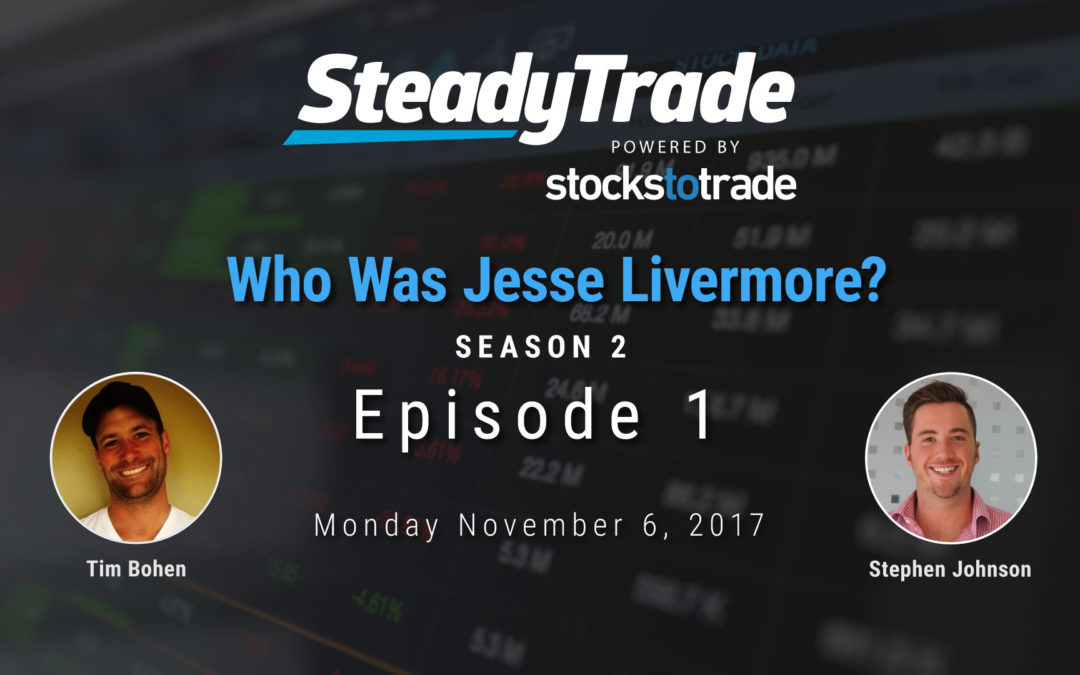Who Was Jesse Livermore ?
iTunes (preferred). Click Here *make sure to subscribe!
Youtube. Click here
Sometimes you’ve got to look to the past before you can bravely forge into the future. With that in mind, our new collection of episodes commences by hopping in a time machine and going back in time: all the way back to the turn of the 19th century (yes, that’s the 1800s-1900s) to explore the life and work of the man who is considered the very first day trader: Jesse Livermore.
While times have changed quite dramatically since Livermore’s heyday, there are an unbelievable amount of lessons that we can still learn today from his work. In the episode, Tim and Stephen explore those lessons and how they can inform your work as a trader in the modern era.
Who was Jesse Livermore?
Jesse Livermore, who was eventually nicknamed “Boy Plunger” owing to his tendency to go heavy on the short selling side of things and pull big profits, got his start as a trader in his early teens. Today, we have StocksToTrade and many other resources at our fingertips. However, in the late 1800s, things were a little different. Jesse’s first job was as a runner at a brokerage firm: he would literally confer with the person who was receiving stock information via telegraph, and write the information on a large board for investors to view.
Without a full understanding of what stocks even were, Jesse began to notice trends in the numbers he was posting. Without realizing it, he was doing intuitively what day traders are still attempting to master today: noticing and identifying and following trends. Eventually, he decided to start betting.
Bucket Shops
There was no WIFI in the 1800s (the horror!). As such, the way that investors could trade was a little different. Lacking a position in a brokerage firm, speculators would actually gamble on stocks in establishments known as Bucket Shops.
A Bucket Shop was really a type of gambling establishment, where individuals would bet on stock prices, but did not actually buy or sell the stock. Basically, you’d put money in the “bucket” and if the stock performed as you bet it would, you’d receive a payoff. It was kind of like betting on horses or dogs at the track, but with stocks.
While a Bucket Shop could be seen as a predecessor of the “Boiler Room” made so famous in The Wolf of Wall Street, they differed in that the bets didn’t actually affect the price of the stock.
It was in these Bucket Shops that Livermore began his career. He was rewarded: by the age of 15, he had made his first thousand dollars. A thousand dollars would be a cash cow to a teenager today, so imagine how incredible this would have been circa 1900!
In the episode, Tim and Stephen discuss the progression of Livermore’s career and how over time he would have a big effect on the market and would gain (and lose) millions of dollars over time.
Key lessons from Jesse Livermore
After discussing Jesse Livermore’s fascinating story, Tim and Stephen delve into the lessons that can be learned from his career. Here are some of the key lessons we can learn:
- The money is real: Perhaps due to the fact that he gained success so early, Jesse had a problem with perceiving the money he traded as being “real”. Actually, this remains a problem for traders today; Tim and Stephen discuss how to avoid this common trading mistake.
- Do your research: Jesse Livermore states that when he was certain that a stock would go up or down, it typically performed as he predicted. The problem is that this certainty doesn’t come without proper research. In the episode, Tim and Stephen offer tips for psychologically and practically preparing yourself for trades by doing intelligent research.
- The trend is your friend. Jesse Livermore learned the hard way that if he tried to fight the trend, for instance by shorting a stock that was trending up, he would lose. He did in fact lose a lot of money during his career and was even borderline homeless at times. In discussing this idea, Tim and Stephen offer specific tips on how to go with the flow of a stock.
- Be your own trader. You can learn from every source possible, and should, but ultimately, to be successful as a trader, you need to take the time to learn the rules and develop your own style. Jesse didn’t depend on anyone else’s tips and was very much an independent trader. Tim and Stephen delve into this topic, offering tips for striking the perfect balance between consulting sources and educating yourself but also making your own decisions when it comes to stocks.
- History rhymes. History doesn’t repeat itself exactly, but as Tim often says, it “rhymes”. Basically, you can learn from your own past as a trader and let it inform your future. This is a lesson that Jesse Livermore learned, and one that Tim and Stephen discuss in greater detail in the episode, offering constructive tips for improving your trading by keeping records.
Incorporating Jesse Livermore’s lessons
Even though Jesse Livermore is long gone and traded in a different era, there are things that hold true even after all of these years and the technological developments that have occurred since his time. Stocks change, technology changes, and there are new developments all the time. But human nature and the market don’t totally change. Therefore these lessons still ring true and can very much improve your trading today.
Win big!
A new season of the SteadyTrade Podcast means all new prizes! Stay tuned for our official announcement about the Season Two Mega-Giveaway . Also, stay tuned for the next episode, where we will feature an inspiring trader interview!




How about a link to leaving an iTunes review?
Loved this episode, I’m going to read the book as soon as it comes! Its encouraging to me that the stock market changes but constantly repeats, that means that I who am just learning, had never had previous experience…that I can learn this, cause eventually it will all come full circle again. Maybe a different day, but it will.
Loved it! Brings out my curiosity for the market history and how they used to do things and how much it has changed. Will definitely be doing research on the market history and learning more. Keep up the good work. Appreciate it.
How do I recover my password?
Thank you for coming back with a review of the greatest book of all time on trading. You guys convinced me to read it again. Trading in the Zone by Douglas is an awesome book as well (we can go on…) as he puts a lot of emphasis on probability rather than expectation…
This definitely gets me interested in learning about the history of trading and how it developed. I’m really interested in learning about the milestones that happened in trading to get us here. Like when did they start to create charts for stocks vs just looking at the tape of sales. And how they came up with the different ways to chart stocks. Great episode guys, super interesting!!! Keep it up! And great quotes pulled from the book!
Good suggestion! I like the “history of markets” segment idea! Thanks
Great cast guys, really enjoyed it, I ordered the book to read while I watched, love the history lesson Reminiscences of a Stock Operator & How to Trade In Stocks to add to my knowledge bank. Excellent stuff thanks alot
Thanks Rads!
Every popcast is been just GREAT, helping my knowledge grow , understand & learn more with every episode Thank you Tim & Stephen
It was interesting to hear about the history of trading and how it has changed.
Glad you found it useful Natalia!
Great episode, from what I understood, it looks like the same principles on price action moves from tickers and trends. Great History! I need to read the book or listen to it like Stephen 😉
Must read book!! Or listen 🙂
Thanks
Awesome episode, next book on my list!
Best Episode so far; love(d) the book (currently reading it), obviously loved the podcast as well!
I want an STT T-shirt with the Quote
A time to go Long,
A time to go Short,
A time to go Fishing.
=)
Coming soon!! 🙂
Thank you for introducing the famous Jesse Livermore!
These lessons are as true today as they were then. As Livermore put it, “there is nothing new in Wall Street. There can’t be because speculation is as old as the hills. Whatever happens in the stock market today has happened before and will happen again.”
I was surprised, I read this book a long time ago, then reread it for the podcast, still so relevant today.
Most interesting. Good podcast.
Thanks John!
Way cool! Some very valid points! I appreciate you penning this post
and also the rest of the site is very good.
thank you guys!